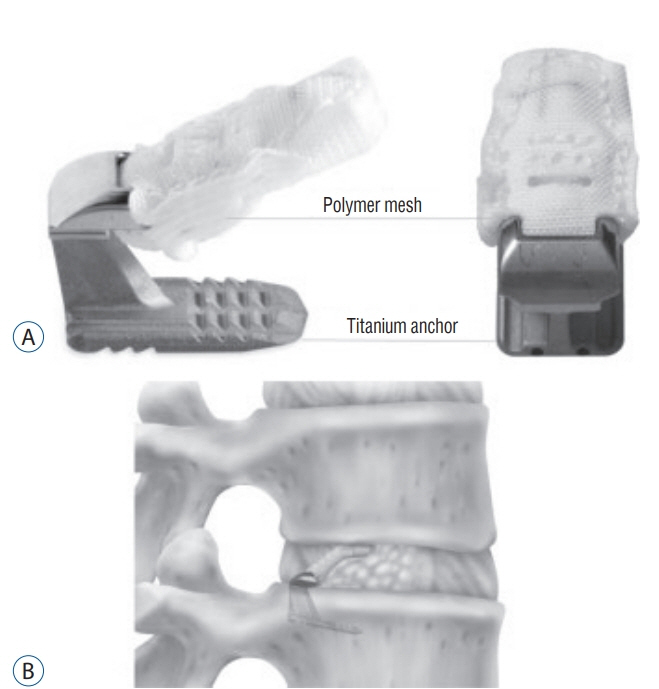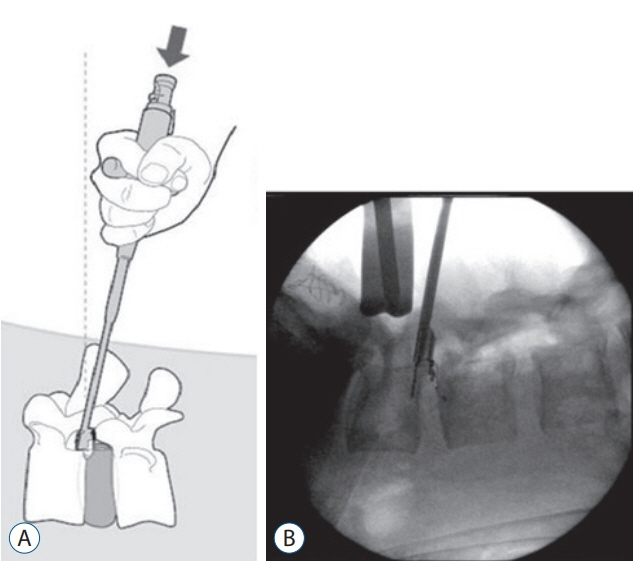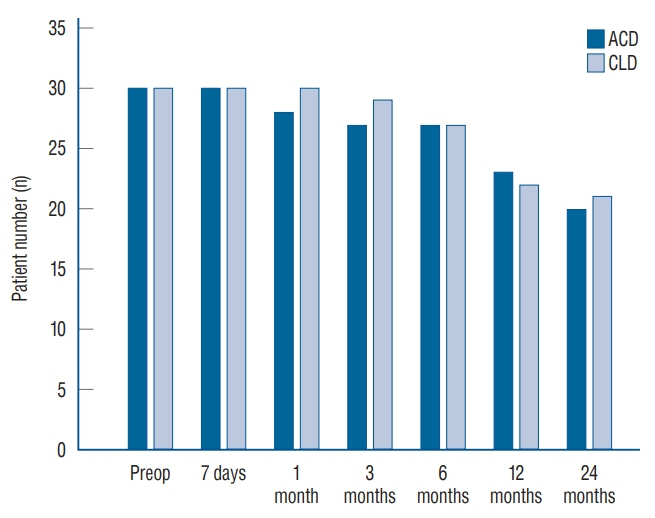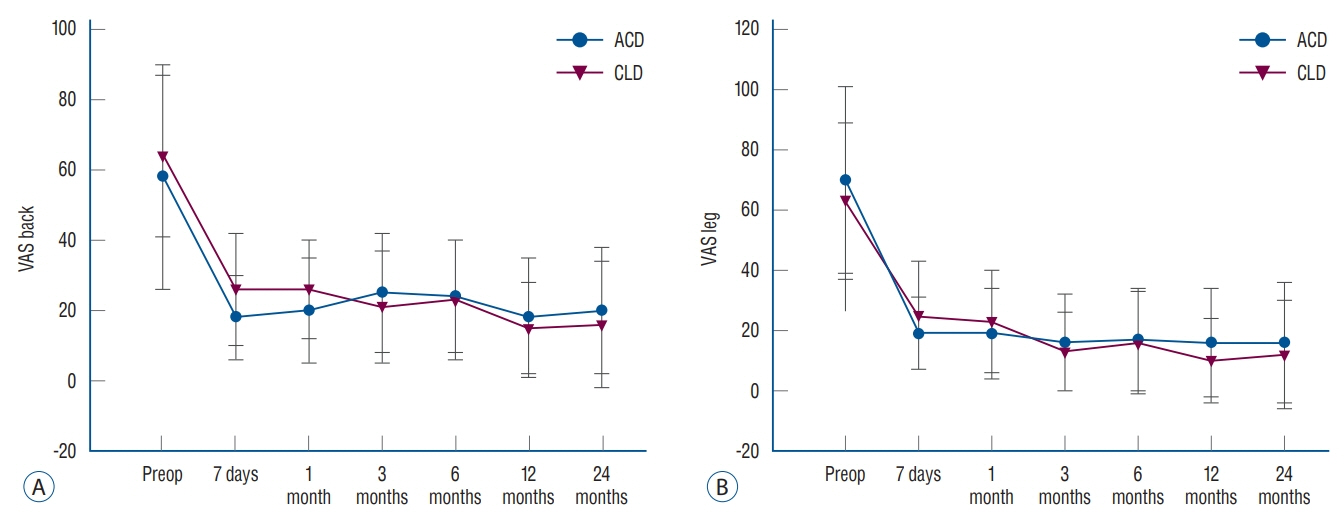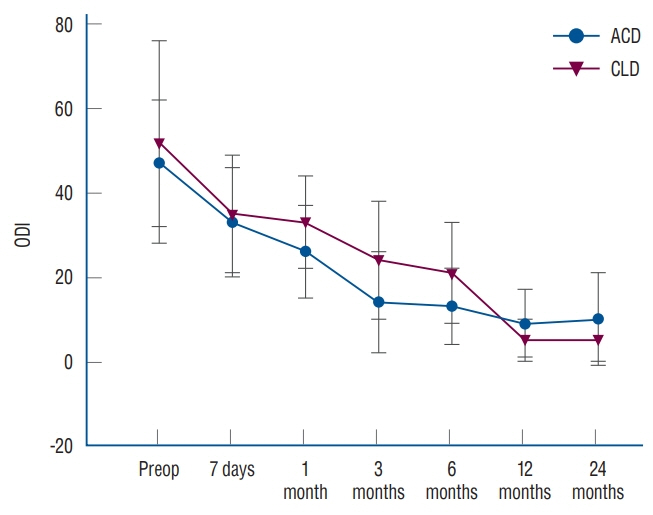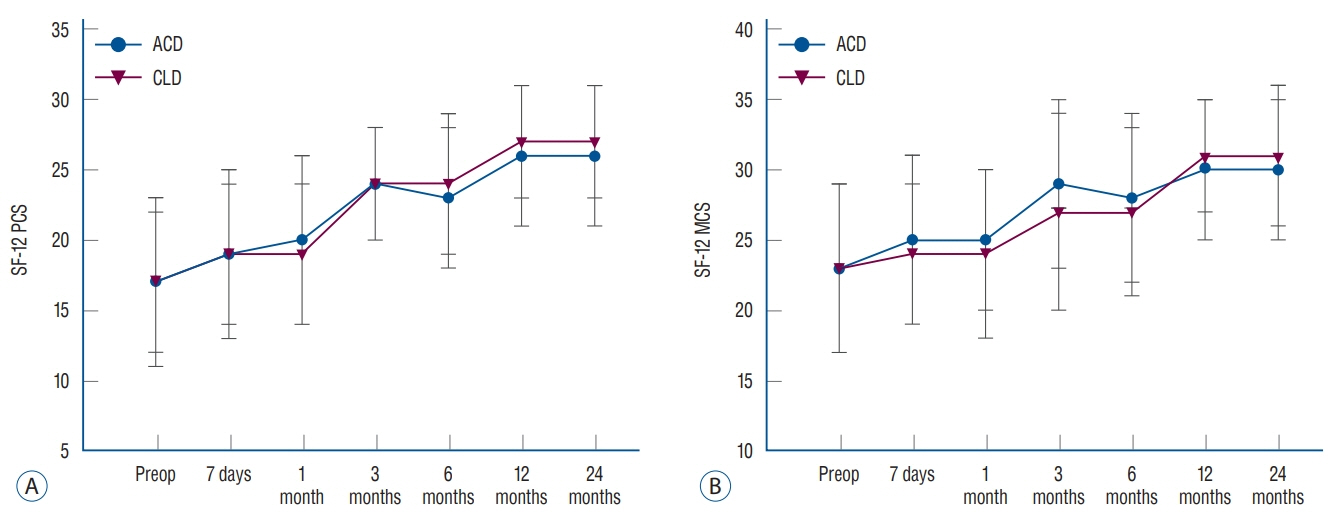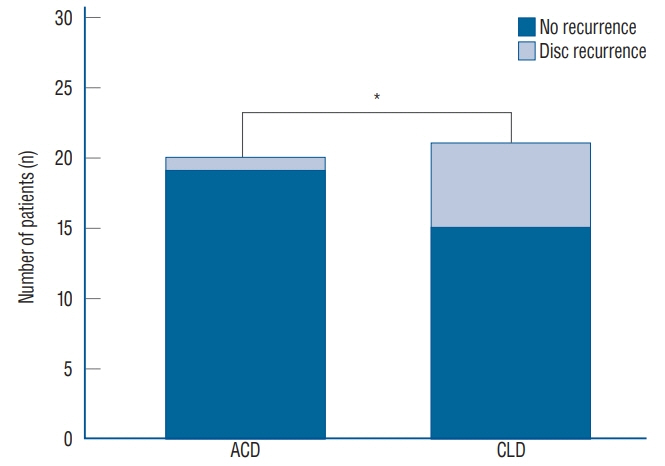J Korean Neurosurg Soc.
2019 Nov;62(6):691-699. 10.3340/jkns.2019.0071.
Efficacy of a Novel Annular Closure Device after Lumbar Discectomy in Korean Patients: A 24-Month Follow-Up of a Randomized Controlled Trial
- Affiliations
-
- 1Department of Neurosurgery, Ajou University College of Medicine, Suwon, Korea.
- 2Department of Neurosurgery, Yonsei University College of Medicine, Seoul, Korea.
- 3Department of Neurosurgery, Hwalkichan Hospital, Goyang, Korea.
- 4Department of Neurosurgery, Cham Teun Teun Research Institute, Seoul, Korea. jivago91@gmail.com
- KMID: 2463661
- DOI: http://doi.org/10.3340/jkns.2019.0071
Abstract
OBJECTIVE
Lumbar discectomy is an effective treatment for lumbar disc herniation (LDH); however, up to 2-18% of patients with LDH have experienced recurrent disc herniation. The purpose of this study was to evaluate the efficacy of a novel annular closure device (ACD) for preventing LDH recurrence and re-operation compared with that of conventional lumbar discectomy (CLD).
METHODS
In this prospective randomized controlled trial, we compared CLD with discectomy utilizing the Barricaid® (Intrinsic Therapeutics, Inc., Woburn, MA, USA) ACD. Primary radiologic outcomes included disc height, percentage of preoperative disc height maintained, and re-herniation rates. Additional clinical outcomes included visual analog scale (VAS) scores for back and leg pain, Oswestry Disability Index (ODI) scores, and 12-item short-form health survey (SF-12) quality of life scores. Outcomes were measured at preoperation and at 1 week, 1, 3, 6, 12, and 24 months postoperation.
RESULTS
Sixty patients (30 CLD, 30 ACD) were enrolled in this study. At 24-month follow-up, the disc height in the ACD group was significantly greater than that in the CLD group (11.4±1.5 vs. 10.2±1.2 mm, p=0.006). Re-herniation occurred in one patient in the ACD group versus six patients in the CLD group (χ²=4.04, p=0.044). Back and leg VAS scores, ODI scores, and SF-12 scores improved significantly in both groups compared with preoperative scores in the first 7 days following surgery and remained at significantly improved levels at a 24-month follow-up. However, no statistical difference was found between the two groups.
CONCLUSION
Lumbar discectomy with the Barricaid® (Intrinsic Therapeutics, Inc.) ACD is more effective at maintaining disc height and preventing re-herniation compared with conventional discectomy. Our results suggest that adoption of ACD in lumbar discectomy can help improve the treatment outcome.
MeSH Terms
Figure
Reference
-
References
1. Bouma GJ, Barth M, Ledic D, Vilendecic M. The high-risk discectomy patient: prevention of reherniation in patients with large anular defects using an anular closure device. Eur Spine J. 22:1030–1036. 2013.
Article2. Brazier JE, Harper R, Jones NM, O’Cathain A, Thomas KJ, Usherwood T, et al. Validating the SF-36 health survey questionnaire: new outcome measure for primary care. BMJ. 305:160–164. 1992.
Article3. Carragee EJ, Han MY, Suen PW, Kim D. Clinical outcomes after lumbar discectomy for sciatica: the effects of fragment type and anular competence. J Bone Joint Surg Am. 85:102–108. 2003.4. Carragee EJ, Spinnickie AO, Alamin TF, Paragioudakis S. A prospective controlled study of limited versus subtotal posterior discectomy: shortterm outcomes in patients with herniated lumbar intervertebral discs and large posterior anular defect. Spine (Phila Pa 1976). 31:653–657. 2006.
Article5. Davis RA. A long-term outcome analysis of 984 surgically treated herniated lumbar discs. J Neurosurg. 80:415–421. 1994.
Article6. Gray DT, Deyo RA, Kreuter W, Mirza SK, Heagerty PJ, Comstock BA, et al. Population-based trends in volumes and rates of ambulatory lumbar spine surgery. Spine (Phila Pa 1976). 31:1957–1963. 2006.
Article7. Heindel P, Tuchman A, Hsieh PC, Pham MH, D’Oro A, Patel NN, et al. Reoperation rates after single-level lumbar discectomy. Spine (Phila Pa 1976). 42:E496–E501. 2017.
Article8. Kepley AL, Nishiyama KK, Zhou B, Wang J, Zhang C, McMahon DJ, et al. Differences in bone quality and strength between Asian and Caucasian young men. Osteoporos Int. 28:549–558. 2017.
Article9. Ledic D, Vukas D, Grahovac G, Barth M, Bouma GJ, Vilendecic M. Effect of anular closure on disk height maintenance and reoperated recurrent herniation following lumbar diskectomy: two-year data. J Neurol Surg A Cent Eur Neurosurg. 76:211–218. 2015.
Article10. Lequin MB, Barth M, Thomė C, Bouma GJ. Primary limited lumbar discectomy with an annulus closure device: one-year clinical and radiographic results from a prospective, multi-center study. Korean J Spine. 9:340–347. 2012.
Article11. Martin BI, Mirza SK, Flum DR, Wickizer TM, Heagerty PJ, Lenkoski AF, et al. Repeat surgery after lumbar decompression for herniated disc: the quality implications of hospital and surgeon variation. Spine J. 12:89–97. 2012.
Article12. McGirt MJ, Ambrossi GL, Datoo G, Sciubba DM, Witham TF, Wolinsky JP, et al. Recurrent disc herniation and long-term back pain after primary lumbar discectomy: review of outcomes reported for limited versus aggressive disc removal. Neurosurgery. 64:338–344. 2009.13. McGirt MJ, Eustacchio S, Varga P, Vilendecic M, Trummer M, Gorensek M, et al. A prospective cohort study of close interval computed tomography and magnetic resonance imaging after primary lumbar discectomy: factors associated with recurrent disc herniation and disc height loss. Spine (Phila Pa 1976). 34:2044–2051. 2009.
Article14. Parker SL, Grahovac G, Vukas D, Vilendecic M, Ledic D, McGirt MJ, et al. Effect of an annular closure device (barricaid) on same-level recurrent disk herniation and disk height loss after primary lumbar discectomy: two-year results of a multicenter prospective cohort study. Clin Spine Surg. 10:454–460. 2016.15. Spengler DM. Lumbar discectomy. Results with limited disc excision and selective foraminotomy. Spine (Phila Pa 1976). 7:604–607. 1982.16. Strömqvist B, Fritzell P, Hägg O, Jönsson B, Swedish Society of Spinal Surgeons. The Swedish spine register: development, design and utility. Eur Spine J 18 Suppl. 3:294–304. 2009.
Article17. Trummer M, Eustacchio S, Barth M, Klassen PD, Stein S. Protecting facet joints post-lumbar discectomy: barricaid annular closure device reduces risk of facet degeneration. Clin Neurol Neurosurg. 115:1440–1445. 2013.
Article18. Watters WC 3rd, McGirt MJ. An evidence-based review of the literature on the consequences of conservative versus aggressive discectomy for the treatment of primary disc herniation with radiculopathy. Spine J. 9:240–257. 2009.
Article19. Yorimitsu E, Chiba K, Toyama Y, Hirabayashi K. Long-term outcomes of standard discectomy for lumbar disc herniation: a follow-up study of more than 10 years. Spine (Phila Pa 1976). 26:652–657. 2001.
- Full Text Links
- Actions
-
Cited
- CITED
-
- Close
- Share
- Similar articles
-
- Use of Annular Closure Device (Barricaid(R)) for Preventing Lumbar Disc Reherniation: One-Year Results of Three Cases
- Primary Limited Lumbar Discectomy with an Annulus Closure Device: One-Year Clinical and Radiographic Results from a Prospective, Multi-Center Study
- A Randomised, Placebo-controlled Trial of the Effects of Preoperative Pregabalin on Pain Intensity and Opioid Consumption following Lumbar Discectomy
- The Effect of Intravenous Paracetamol on Postoperative Pain after Lumbar Discectomy
- The Effect of Topical Tranexamic Acid on Intraoperative Blood Loss in Patients Undergoing Posterior Lumbar Laminectomy and Discectomy: A Randomized, Double-Blind, Controlled Trial Study

